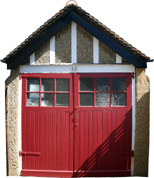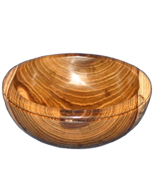

WT Project 2
Experimental Drying
(This page)
I will be using some basic technical terms on this page so lets begin by explaining what they are.
When a living tree is felled, it is in the green state, containing a very large amount of moisture. This moisture exists in two different forms: as free water, contained as liquid in the pores or vessels of the wood, and bound water that is locked within the cell tissues of the wood.
Once a freshly cut piece of timber is exposed to the air, it will immediately begin losing free water. Initially, the wood does not contract or otherwise change in dimension since the fibres are still completely saturated with bound water. Once all the free water has been lost, the wood will reach the fibre saturation point (FSP).
Below the FSP, the wood will begin to lose moisture in the form of bound water, and a corresponding reduction in the volume of the wood tissues will occur. At this point, the wood is no longer considered to be in the green state, and is drying.
How much bound water is lost during drying depends on the temperature and relative humidity (RH) of the surrounding air. At 100% RH, no bound water will be lost. At 0% RH, a steep moisture gradient (MG) will be established and all the bound water in the wood will be progressively lost, to a condition known as oven dry so-called because a kiln or oven is required to completely drive out all the moisture.
The MG depends on the external RH of the surrounding air. As water evaporates from the surface of the wood, more is drawn out from the centre along the gradient thus created. The MG is critically important, as a high rate can create unequal MC's in different parts of the timber, inducing severe stresses. Eventually, with progressive moisture loss, the gradient decreases and stabilizes at a value that is commensurate with the surrounding moisture in the air. At this point, the MC is referred to as the equilibrium moisture content (EMC). The EMC will continue to change (increase or decrease slightly), dependent on the fluctuating temperature and RH of the surrounding air.
The Moisture Content (MC) of wood is calculated by
the formula

Where the wet weight is the weight of the original
'wet' sample and the dry weight (oven dry), being
the weight of the sample after drying in an oven.
Moisture content being expressed as a percentage. Some
species of trees, when they are initially felled, may
contain more water by weight than actual wood fiber,
resulting in a MC of over 100%.
Newly Felled.
When harvesting or obtaining green wood for turning, it
is very useful to know when the timber was felled. If it
was felled the same day or within a few days of
harvesting, then there will certainly be some free
water in the wood and it will not start to contract
in volume until the FSP has been passed and
bound water starts to be lost. This reduces the
urgency of preparation and processing.
Felled Several Weeks/Months ago.
If the wood was felled weeks or months previously and
just left in the round, it is likely that most of the
free water will have been lost and the bound
water will be evaporating with likely contraction and
splitting of the timber, particulary in the vicinity of
the cut extremities, where the rate of drying
(Moisture Gradient), will be most intense.
Such timber should either be prepared as soon as possible to prevent further degradation and possible spoiling by fungal infection, or else the endgrain sealed with some form of sealer (I use PVA emulsion). I have seen some harvested green timber wrapped in cling film to conserve moisture until the time can be found for preparation and conversion.
Prevention of Fungal Infection & Insect
Infestation
If the wood is not being kiln dried, there is a big risk
that, with a high MC, the wood will be infected
with organisms (mainly fungi but also woodworm), which
cause decay and staining. To avoid this it is useful to
treat the wood with a fungicide and insecticide,
especially in the early stages of drying. If the
completed turning is intended for food use then it is
important that the treatment is minimally toxic to
humans. Perhaps the most suitable is Borax (sodium
tetraborate), which is widely used in household mould
treatments and insecticides. This is best obtained as a
powder which can be dissolved (5% - 10% dilution), in
warm water in a non-metallic (plastic) container. It is
most easily liberally applied by brush to the turning,
but the wood, if small enough, can also be dipped.
To obtain consistent results from the monitoring, the drying area should have a reasonably constant RH and temperature. If these vary considerably, then the drying rate and eventual EMC will also show marked fluctuations, making monitoring difficult. If a workshop cannot satisfy these criteria then a possible alternative might be somewhere in a domestic dwelling, where the temperature and RH ranges will in any case, probably mirror that of where the finished turning may end up.
This example is of a rough turned bowl made from freshly felled cherry which, after turning, was simply put on a shelf in the workshop to dry. The bowl was weighed weekly to monitor the drying progress.
![[Photograph of Digital scales - click for larger view] Photograph of Digital scales.](images/img_3081crthmb.jpg)
|
Weighing with Digital scales.
These digital scales weigh objects up to 5,000grams (5Kg), and are ideal for monitoring the weight of green turnings. For large heavy turnings in excess of 5Kg, I use digital bathroom scales! (Click picture for larger view) |
![[Weight recording - click for larger view] Weight Recording.](images/img_3084rotcrthmb.jpg)
|
Weight Recording.
Recording the weight of a rough-turned bowl made of Walnut. (Click picture for larger view) |
![[Weight recording - click for larger view] Weight Recording.](images/written-2010-06crthmb.gif)
|
The hand-written record.
The hand-written sheet detailing the drying record from the day the bowl was rough-turned, on the 30th April 2010, until the final reading some 6 months later on the 17th October. Click HERE to view a PDF blank version of the form which can be printed and used for recording. (Click picture for larger view) |
For interpreting the results, I use a Word-Processor and Spreadsheet. Initially I enter the readings into a table within a document created with either Microsoft Office Word or created with the free Open Office Text word processor.* Just the dates and the weights (in grams) are entered into the table which is set to automatically calculate significant analytical data in the adjacent columns. These analytical columns are very useful if the data is entered as the wood is still drying.
* Note that the Open Office software can read and create Microsoft Word documents & Microsoft Excel Spreadsheets.
A much more meaningful picture of the drying process can be obtained by entering the data into either a Microsoft Office Excel or Open Office Calc spreadsheet (or other software which can generate graphs), to create a line graph of the results.
Note that for presentation here, an Open Office graph has been converted to a JavaScript chart created with AM Charts
The "Danger Period", where the turning is most likely to crack, is in the initial period of drying when the Moisture Gradient is at its highest level and the consequent shrinkage stresses in the timber are at a maximum. This period is highlighted an annotated version of our example graph, shown below.
The obvious way to lessen the drying stresses in the initial drying period is to slow down the drying process by reducing the MG. This can be done in several ways, as follows.
The "Plastic Bag" Method.
This method is commonly used by turners, and involves
placing a "green" turning into a plastic bag folded
over (to seal it), at the top. This inhibits water loss
(the evaporation from the wood, increases the RH
within the bag which stifles the moisture gradient),
and, on a regular basis, the wood is removed, and the
bag turned inside out to allow condensed moisture to
evaporate. The wood is replaced in the inverted bag
until the next set time for removal of the wood and
repeated (un-)inversion of the bag, and evaporation of
the expelled condensed moisture.
A major problem with this, in my experience, is the extensive development of mould on the wood. An effective mould prevention strategy was discussed earlier in this article.
The "Bury in Shavings" Method.
This is another common method where the turning is placed
in a box of shavings and left for a long period of time
(years?), allowing the moisture to dissipate slowly from
the turning and be absorbed in the dry shavings, which
will initially have a lower MC than the wood of
the turning.
This method allows for the turning to be repeatedly, firstly isolated from, and then exposed to the low RH of the drying area for short set periods, which effectively retards the drying process. The drying process can be effectively monitored by simply weighing the wood after each successive drying period.
Typically the newly turned wood is weighed and then immediately placed in a lidded polythene box. Water evaporating from the surface of the wood has nowhere to go, so the RH in the box rapidly increases to the point of equilibrium moisture content. Drying of the wood is thus completely halted. The turning(s) remain(s) in the lidded box for seven days to allow any moisture gradient (and associated stresses), to equalise. On the seventh day, the lid is removed from the box and the wood is allowed to dry for a set period. The weight at the end of this period is recorded before the lid is replaced on the box and it is left for a further seven days to again allow equalization of the MG and associated stresses. Using this cyclical method, the duration of the drying periods, and therefore the rate of drying, can be controlled minutely.
![[Drying green turned wood - click for larger view] Drying green turned wood.](images/img_5303rotcrthmb.jpg)
|
"Experimental Drying Boxes" for Green
Turnings. (Click pictures for larger views) |
![[Drying green turned wood - click for larger view] Drying green turned wood.](images/2011-18-final-recordthmb.gif)
|
"Data from a Cherry Bowl, dried in an
"Experimental Drying Box" (as shown
above). (Click pictures for larger views) |
![[Drying Graph - click for larger view] Drying Graph.](graphs/graph-2011-18thmb.gif)
|
Drying Graph for the Chery Bowl data (in the
above picture). (Click picture to view graph) |
![[Drying green turned wood - click for larger view] Drying green turned wood.](images/graph-2011-18-dangerthmb.gif)
|
Interpretation of the Drying Graph (shown
above). (Click pictures for larger views) |
More experimental data will be added here in due course.
Experiments and their interpretation are usually followed by some conclusions.
Click HERE to return to the Home Page.
© Tim & Trish Enterprises 2015-2017.